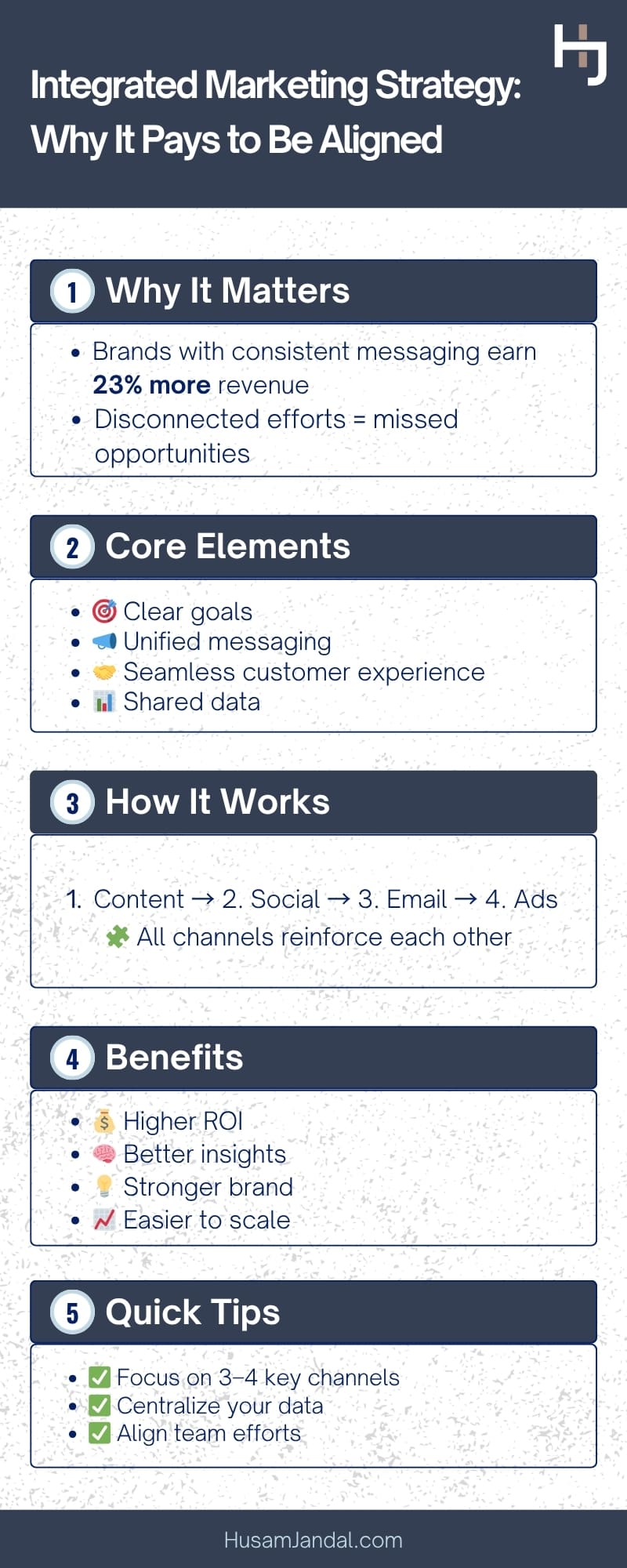 Did you know that businesses with consistent brand messaging across channels see up to 23 percent higher revenue? Yet, many companies, especially smaller ones, still run isolated campaigns, as if what happens on one channel stays there. If you’re still piecemealing things together, it’s time to unify your approach. Below, we’ll explore what an integrated marketing strategy looks like, why developing one is crucial to your long-term success, and how to bring your approach together.
Did you know that businesses with consistent brand messaging across channels see up to 23 percent higher revenue? Yet, many companies, especially smaller ones, still run isolated campaigns, as if what happens on one channel stays there. If you’re still piecemealing things together, it’s time to unify your approach. Below, we’ll explore what an integrated marketing strategy looks like, why developing one is crucial to your long-term success, and how to bring your approach together.
What it Means to Have an Integrated Marketing Strategy
An integrated marketing strategy is a unified approach to marketing in which all your efforts work together to achieve your business goals. Rather than running isolated campaigns or tactics separately, your marketing activities reinforce each other, creating a consistent brand experience for your audience.
Think of integrated marketing like a team sport. Each player, or marketing tactic in this case, has a specific role. When everyone plays together strategically, you’re much more likely to win. If one player is out of sync or disconnected, the entire team suffers.
What’s Included in an Integrated Marketing Strategy
While the approach may vary slightly from one business to the next due to different goals, channels, and audiences, the marketing performance framework typically encompasses the traits described below.
- Clear Business Goals: Your marketing activities directly support specific business objectives, such as increasing revenue or building brand recognition.
- Consistent Messaging: Whether customers find you through social media, email, ads, or your website, the message and tone they encounter are consistent.
- Unified Customer Experience: No matter where customers engage with your brand, they receive the same positive and cohesive experience.
- Shared Data and Insights: Information gathered from one tactic, like email campaigns, is used to improve another, like social media advertising.
What an Integrated Marketing Strategy Looks Like in Practice
Let’s say that your goal is to position your business as an industry leader. Your integrated strategy might look something like the process outlined below.
- Website Content: You’ll share articles, case studies, e-books, and other helpful content showcasing your expertise on your website.
- Social Media: You’ll then share your website content on your social media profiles and highlight key insights.
- Email Campaigns: Next, you’ll share deeper, related information directly with your subscribers to create ongoing engagement.
- Paid Ads: Lastly, you might boost your social media posts or showcase your content in paid ads to drive new visitors to your website, where they immediately see content aligned with the promises made in the ad.
Why Integration is Crucial to Sustainable Marketing Success

Creating an integrated marketing performance framework takes time and intention, but the payoff is well worth the effort. Let’s take a look at what happens behind the scenes when integration is at the heart of your long-term marketing strategy.
Improved Efficiency and ROI
Integrated marketing reduces wasted resources. Because your channels share common goals, content, and data, you avoid duplicating efforts or sending mixed messages. This streamlined approach means you spend your budget smarter and boost your overall return on investment (ROI).
Stronger Brand Awareness
When your message is consistent everywhere customers encounter your brand, it becomes instantly recognizable. People remember you clearly, which helps create a strong brand identity that sets you apart from competitors.
Better Customer Experience
Customers appreciate consistency. Integrated marketing ensures that every interaction, from social media posts to customer service calls, feels connected. This makes your customers feel valued and understood, which strengthens their loyalty to your brand.
Increased Trust and Credibility
Consistent messaging across multiple channels reinforces your business as professional, reliable, and trustworthy. Customers gain confidence when your brand reliably delivers on its promises, no matter where or how they interact with you.
Clearer Insights and Smarter Decisions
When marketing activities share insights and data, you get a clearer picture of what’s working and why. This integration allows you to quickly identify successful strategies and pivot away from less effective efforts, which strengthens your overall marketing.
Easier Scalability and Growth
Integrated strategies build solid marketing foundations, so it’s easier to scale your business. Because the groundwork for alignment, consistency, and data-driven decision-making is already established, you’re better prepared to introduce new channels or increase investment in existing ones.
Tips for Building an Integrated Marketing Strategy
Creating a unified marketing approach isn’t complicated, but you do need to follow a systematic approach.
Set Clear Objectives
Clearly define what you want to achieve through marketing. Your goals might be boosting revenue by 15 percent, doubling website traffic, or expanding your market share. Specific goals help you align your efforts and measure success accurately.
Get to Know Your Audience
Invest time in getting to know your customers on a deep level. Consider what motivates them, the challenges they face, and how they prefer to communicate. Use these insights to craft messages that resonate across every marketing channel.
Create a Consistent Message and Tone
Document your brand voice, messaging, and visual identity clearly. Ensure your entire marketing team has access to these guidelines so that every interaction your customers have with your brand feels consistent.
Choose Channels Strategically
Focus your resources on marketing channels that your audience uses most frequently. Rather than spreading your efforts thin across many channels, select three or four channels and integrate them deeply, ensuring each supports the others.
Centralize Your Data
Connect data from all marketing activities into a single place whenever possible. Centralized data allows your team to see what’s working, track customer journeys accurately, and make informed decisions quickly.
Communicate and Collaborate Regularly
Your marketing team should meet regularly to review performance, share insights, and plan future efforts collaboratively. Integration thrives when there’s clear and open communication among all involved.
Measure and Adjust
Integrated marketing is dynamic and evolves along with your customers and business goals. Continuously track your results and adjust your approach based on the insights you gather.
Get Help Developing an Integrated Marketing Strategy
Most businesses start off with a fragmented approach simply because everyone is juggling multiple roles and learning as they go. But at a certain point, that grit and determination stops delivering results. To get things back on track, you not only need an integrated marketing strategy but also someone with the expertise to bring everything into alignment. That’s what I do, and I’ve been helping small businesses and Fortune 100 companies alike boost their success for more than 20 years. If you’d like to explore what this might look like for your business, let’s talk.
Integrated Marketing Strategy FAQs
Why do one-off marketing campaigns often fail?
One-off marketing campaigns often fail because they lack consistency and long-term strategic alignment. Without integration, each campaign may work in isolation, failing to reinforce overall business goals. As a result, they don’t build lasting relationships or sustain customer engagement, making it harder to see long-term growth.
How can I build a sustainable marketing system for long-term growth?
To build a sustainable marketing system, focus on creating a cohesive strategy with clear objectives, consistent messaging, and cross-channel marketing. Align all activities around your core business goals and gather insights from each channel to continuously optimize and scale your efforts, ensuring long-term growth and engagement.
What are the key components of an effective integrated strategy?
Key components of an effective integrated strategy include clear business objectives, consistent messaging across all channels, customer-focused content, data-driven decisions, and a unified customer experience. This ensures each marketing activity supports and enhances the others, driving better results and reinforcing your overall brand.
How do I align messaging across multiple marketing channels?
To align messaging across multiple marketing channels, develop a cross-channel marketing plan with clear, consistent brand guidelines. This ensures that messaging, tone, and design are uniform across email, social media, content, and ads. Regularly review and update your messaging to ensure it resonates consistently across all customer touchpoints.
What’s the difference between integrated and multichannel marketing?
Integrated marketing focuses on unifying all channels into a cohesive strategy, ensuring each tactic works together toward a common goal. Multichannel marketing, on the other hand, involves using different channels (such as social media, email, and paid ads) without necessarily aligning them into a unified strategy, which can result in fragmented messaging.
Why is consistency in brand messaging important for ROI?
Brand consistency ensures customers receive a unified experience, building trust and recognition. Consistent messaging increases customer loyalty and improves conversion rates, directly impacting ROI. When all marketing channels reinforce the same message, your brand becomes more memorable, leading to higher returns on your marketing investments.
How can marketing and sales work together in an integrated model?
Marketing and sales can work together in an integrated model by sharing data and collaborating on customer insights. Marketing provides sales teams with qualified leads, while sales feedback helps refine marketing strategies. This alignment ensures that both teams are focused on the same goals, enhancing customer acquisition and retention.
What are the best tools or frameworks for integrated marketing planning?
Effective tools and frameworks for integrated marketing planning include platforms like HubSpot, Google Analytics, and Wrike. These tools can help you manage cross-channel campaigns, track performance, and collaborate effectively across teams. Frameworks like the Digital Marketing Tree also guide businesses in aligning strategy and tactics for optimal results.
How do you measure the success of a long-term marketing strategy?
Success in a long-term marketing strategy is measured by tracking key performance indicators (KPIs) such as customer acquisition cost, lifetime value, brand awareness, and engagement metrics. Consistent monitoring and analysis help adjust efforts for continuous improvement, ensuring alignment with long-term business objectives.
Can small teams implement integrated marketing strategies effectively?
Yes, small teams can effectively implement integrated marketing strategies by prioritizing key channels and focusing on cohesive messaging. Tools for automation, collaboration, and data analysis help streamline processes. With a clear plan and efficient use of resources, small teams can successfully integrate marketing efforts and drive meaningful results.
What are examples of companies that use integrated marketing well?
Companies like Apple, Coca-Cola, and Nike are known for executing integrated marketing strategies. They align their messaging across advertising, social media, and in-store experiences, creating a seamless customer journey. These brands ensure consistency and clarity at every touchpoint, which strengthens customer loyalty and drives long-term success.
How do I shift from tactical execution to strategic marketing thinking?
Shifting to strategic marketing thinking involves focusing on long-term goals and how each marketing tactic contributes to those goals. Instead of executing individual campaigns, develop an integrated strategy with a clear vision. Regularly assess performance, refine your approach, and ensure all activities are aligned with your business objectives.
What’s the ROI of investing in brand alignment and consistency?
The ROI of investing in brand alignment and consistency is significant. Consistent branding leads to stronger customer recognition, trust, and loyalty. Consistent brand presentation can increase revenue by up to 23 percent, according to Inc. Magazine. Brand consistency fosters customer relationships, enhances credibility, and supports long-term profitability.
How can I get leadership buy-in for a more cohesive marketing approach?
To get leadership buy-in, focus on the long-term benefits of an integrated marketing strategy, such as improved ROI, stronger brand identity, and better customer retention. Present data that highlights the effectiveness of cohesive marketing approaches and emphasize how it aligns with business goals, providing a clear path for growth.
What is marketing systems thinking?
Marketing systems thinking involves viewing your marketing efforts as interconnected parts of a larger system. It emphasizes understanding how each tactic impacts the others, ensuring alignment with business objectives. This approach allows for smarter decision-making, better resource allocation, and more effective long-term strategies for growth.





































































